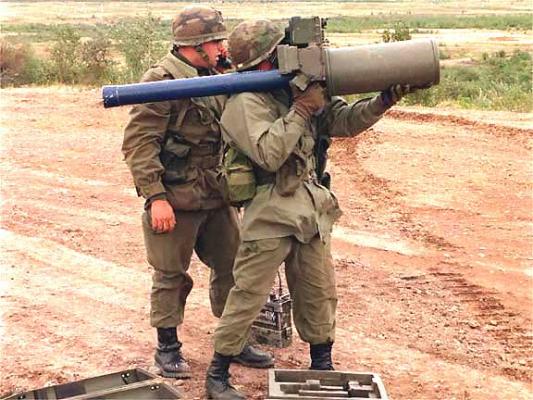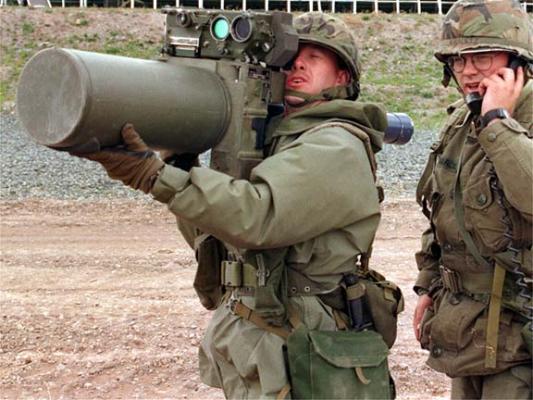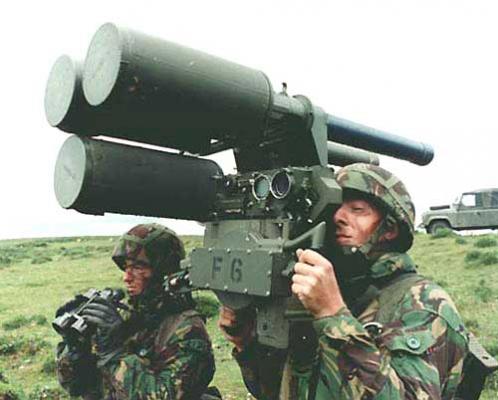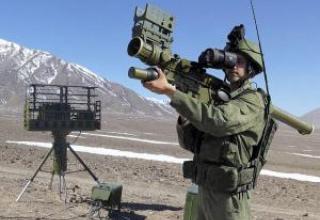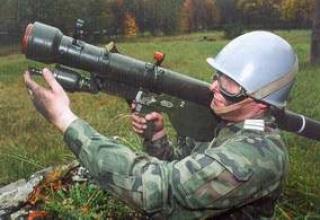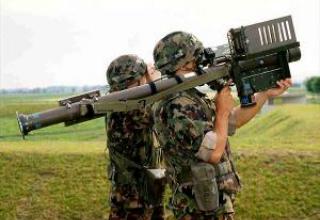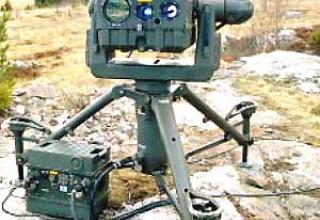Javelin" portable anti-aircraft missile system (MANPADS) is designed for self-defense of ground forces units on the battlefield against attacks of a wide class of air attacks, flying at low and extremely low altitudes. In extreme cases, the system can also be used to destroy ground targets at ranges up to 3 km.
Javelin" complex was developed by "Thales Air Defence Ltd" ("Belfast Northern Ireland" - former name "Shorts Missile Systems") on the basis of "Blowpipe" man-portable air defence systems, but unlike it is equipped with a semi-automatic radio command guidance system, has increased range and power of the combat unit. According to the specialists of the developer company, the use of the Javelin man-portable air defense system gives this complex some advantages over similar systems with infrared sensors. The main advantages are: the possibility of confident firing of targets on counter courses, the ability to fight air targets with different types of engines, as well as insensitivity to heat traps.
Series production of Javelin complex (original designation "Blowpipe - Mk2") was started in 1984, the same year the complex was adopted by the British Navy. In the mid-90s, the "Javelin" man-portable air defence system was replaced by the "Starburst" system for the same purpose in the British Armed Forces. Currently, serial production has been completed and more than 16,000 missiles have been produced. Javelin man-portable air defence systems are in service with several countries, including Canada, Jordan, South Korea, Oman, Peru and Botswana.
Composition:
The Javelin man-portable air defence system consists of a missile in a transport and launch container (TLC), a launch mechanism, a battery and sighting equipment. The TPK has a minimum weight and is designed according to the principle of recoil reduction at firing. The front cover of the container, made of plastic, is detached under the pressure of gases generated during the launch of the rocket's starting engine. In addition, the Javelin man-portable air defense system can be equipped with "own" identification equipment and a night sight.
In comparison with the "Blowpipe" system, the Javelin man-portable air defence system has a more powerful combat unit and is equipped with a new marching engine. Its high specific impulse is explained by the use of new fuel, which allows increasing the range of targets. The combat unit is located in the center of the missile body, the control system - in the front part, and the engine - in the tail. There are four deltoid-shaped wings placed on a free-spinning ring at the nose of the missile and four wings at the tail end of the hull. When the missile is placed in the TIC console front wings are folded, and open after its exit from the container. Due to the free rotation of the wings and their location at some angle to the longitudinal axis of the missile provides its aerodynamic stability in flight.
The sighting unit is located in its own container on the right side of the launcher. This container contains a stabilized sight, which provides manual tracking of the target, and a television camera, which is used to semi-automatically point the missile at the target on the three-point method. After the reticle has been attached to the man-portable air defence system container, Javelin is ready for engagement in less than 5 seconds.
Information about the possibility of an airborne attack is received by the shooter via a radio line over the warning network, or the target is detected independently by a space survey. The shooter observes the target in a monocular sight and, when it reaches the far end of the launch area, activates the trigger mechanism. The shooter must select the frequency at which the transmitter will send guidance commands to the missile.
After the trigger is pressed, two thermal batteries are started, power is supplied to the sighting device and the missile. After the pyro-charge is triggered, the gyroscope rotor is rotated under the influence of the generated gases, and then the starting engine is started (it runs for 0.2 seconds before the rocket leaves the TPK). At a safe distance from the shooter, the marching engine starts to accelerate the missile to a speed of M=1.7. In the absence or disappearance of guidance signals, the missile will self-destruct. At this time a round red mark will appear on the TV camera screen.
Unlike the Blowpipe complex in the Javelin man-portable air defence system, the guidance system automatically guides the missile along the line of sight throughout the missile's flight. This is provided by means of a miniature television camera, which receives the radiation of tracers placed in the tail of the missile. The camera screen shows marks from the target and the missile, their coordinates are processed by a microprocessor-based computer device, and then control commands are transmitted to the missile. A sighting mark is projected in the field of view of the optical sight, which the shooter uses a joystick to combine with the target. The warhead is detonated by means of contact or non-contact fuses.
Shorts Missile Systems has developed the LML (Lightweight Multiple Launcher), which is designed to destroy multiple targets. All LML systems use three standard "Javelin" missiles in the TIC, docked to the standard sighting unit. The Multiple Launcher is located on a tripod or placed on different chassis.
Characteristics:
| Defeat range for "aircraft" type target, km | 0.3 - 4.5 |
| Defeat range for helicopter-type target, km | 0.3 - 5.5 |
| Defeat height, km | 0.01 - 3.0 |
| The diameter of the rocket, mm | 76 |
| The length of the rocket, mm | 1390 |
| Wingspan, mm | 270 |
| Maximum missile speed | 1.7М |
| Mass of the rocket, kg | 12.7 |
| Missile warhead weight, kg | 2.74 |
| Weight of combat unit BB, kg | 0.6 |
| Mass of the rocket in the TPC, kg | 15.4 |
| Weight of sighting unit, kg | 8.9 |
| The field of view of the TV camera is wide, mm | 5.75 х 4.5 |
| TV camera view field is narrow, mm | 0.9 х 0.9 |
Testing:
One of the first carriers of the complex is a multipurpose nuclear submarine of the project 885 "Ash", which belongs to the fourth generation of submarines. The keelmark in the series, called "Severodvinsk", took place on December 21, 1993. The boat carries 24 missiles in inclined launch shafts. The natural model of the new anti-ship missile in an export version (a variant for underwater, surface and shore-based), was first publicly demonstrated at the exhibition MAKS-97. It was also exhibited at MAKS-99.
The advertising passport for the small rocket ship of project 21632 "Tornado" (approved on 26.04.2008) indicates the possibility of placing the Yakhont complex as one of the weapon variants.
According to military analysts' forecasts, the Yakhont complex will have no analogues in the world for another 10 years. This can be proved by the interest expressed by foreign buyers. A number of countries of the Asia-Pacific region, the Middle East, which in the past bought Russian ships and boats with cruise missiles, have already become interested in the novelty of the domestic military industrial complex. PCR Yakhont also has good prospects in terms of upgrading foreign-built ships, where it can replace the Harpoon, Exocet, and Otomat anti-ship complexes.
Sources:
- Василин Н.Я., Гуринович А.Л. "Зенитные ракетные комплексы" .-Мн.: ООО "Попурри", 2002- 464с.
- Canadian Forces Very-Short-Range Air Defence System — the Javelin (http://www.sfu.ca)
